The importance of multicultural literature and its role in the English language teaching
DOI:
https://doi.org/10.18485/zivjez.2022.42.1.8Keywords:
multicultural literature, intercultural competence, English language teachingAbstract
The aim of this paper is to emphasise the importance of adequately selected literary texts in the English language teaching with the aim of helping students develop intercultural competence. The contemporary society consists of intercultural encounters, in order for the communication to be successful, multicultural teaching is recommended as a potential link between the members of the native and target culture. In this paper, we will emphasize the importance of multicultural texts that should be used in the classroom from an early age to help students not only develop language skills, but also learn about the world, and create a personal and critical attitude towards it. Choosing an adequate text (e.g. picture books, fairy tales, folk tales, short stories, contemporary prose) is of the utmost importance. Depending on the students' interests, age and the level of language proficiency, well-chosen text and the adequate approach to the literary anlysis will help students develop empathy towards the Other. The application of contemporary cultural theories can affect student's ability to recognize ideologically colored texts. In this paper, several activities and tips that can be applied in teaching will be proposed in order to help students develop intercultural competence by using literary texts.
References
Adam, H., Harper, L. 2016. Assessing and selecting culturally diverse literature for the classroom. Practical Literacy: The Early & Primary Years, 21(2), 10–14.
Arslan, H. 2013. Multicultural education: Approaches, dimensions and principles. In H. Arslan, G. Rata (eds.), Multicultural education: From theory to practice (pp. 15–34). Newcastle: Cambridge Scholars Publishing.
Byram, M. 1997. Teaching and assessing intercultural communicative competence. Clevedon, UK: Multilingual Matters.
Byram, M., Nichols, A., Stevens, D. 2009. Introduction. In M. Byram, A. Nichols & D. Stevens (eds.), Developing intercultural competence in practice (pp. 1–8). Exeter, England: Cromwell Press.
Bennett, C. 1995. Comprehensive multicultural education theory and practice. Boston: Allyn & Bacon.
Banks, J. A., Banks, C. A. M. 2016. Multicultural education: Issues and perspectives. New Jersey: Wiley.
Banks, J. A. 2009. Multicultural education: Dimensions and paradigms. In J. A. Banks (ed.), The Routledge international companion to multicultural education (str. 9 – 32). New York: Routledge.
Bland, J. 2016. English language education and ideological issues: Picturebooks and viversity. CLELEjournal, 4(2), 41–64.
Голник и Чин 2016: Gollnick, D. M., Chinn, P. C. 2016. Multicultural education in a pluralistic society. Upper Saddle River, NJ: Pearson Education.
Gómez Rodríguez, L. F. 2012. Fostering intercultural communicative competence through reading authentic literary texts in an advanced Colombian EFL classroom. A constructivist perspective. Profile, 14(1), 49–66.
Gómez Rodríguez, L. F. 2013. Enhancing intercultural competence through U.S. multicultural literature in the EFL classroom. Folios Journal, 38, 95–109.
Gómez Rodríguez, L. F. 2015. The cultural content in EFL textbooks and what teachers need to do about it. PROFILE Issues in Teachers’ Professional Development, 17(2), 167–187.
B. Diamond, D., Moore, M. 1995. Multicultural literacy: Mirroring the reality of the classroom. White Plains, NY: Longman Publishing Co.
Đorđević, J. 2009. Postkultura: Uvod u studije kulture. Beograd: Clio.
Cai, M. 2002. Multicultural literature for children and young adults: Reflections on critical issues. Westport, CT: Greenwood.
Kaminski, A. 2013. From reading pictures to understanding a story in the foreign language. CLELEjournal, 1(1), 19–38.
Kramsch, C. 2001. Content and culture in language teaching. Oxford: Oxford University Press.
Kramsch, C. 2011. The symbolic dimensions of the intercultural. Language Teaching, 44(3), 354–367.
Kramsch, C. Zhu, H. 2016. Language and culture in ELT. In G. Hall (ed.), The Routledge handbook of English language teaching (pp. 38–50). Abingdon, Oxon: Routledge.
Meier, T. 2003. “Why can't she remember that?" The importance of storybook reading in multilingual, multicultural classrooms. The Reading Teacher, 57(3), 242–252.
Mohammadzadeh, B. 2009. Incorporating multicultural literature in English language teaching curriculum. Procedia Social and Behavioural Sciences, 1(1), 23–27.
Page, M. E., Sonneburg, P. M. 2003. Colonialism: An international, social, and political encyclopedia. Santa Barbara: ABC-CLIO.
Pratt, M. 2002. Arts of the Contact Zone. In J.M. Wolff (ed.), Professing in the contact zone: Bringing practice and theory together: National Council of Teachers of English (pp. 1–18). Urbana, Illinois: NCTE.
Said, E. 2000. Orijentalizam. Beograd: Biblioteka XX vek.
Sung, Y. K., Meyer, R. J. 2012. Rethinking cultural authenticity in global literature: A Korean example. In R. Meyer & K.F. Whitmore (ed.), Reclaiming reading: Teachers, students, and researchers regaining spaces for thinking and action (pp. 163–166). New York/London: Routledge.
Short, G. K., Lynch-Brown, C. G., Tomlinson, L. 2014. Essentials of children’s literature. Boston, MA: Pearson.
Published
How to Cite
Issue
Section
License
Copyright (c) 2022 Јована Николић

This work is licensed under a Creative Commons Attribution-NonCommercial-ShareAlike 4.0 International License.


